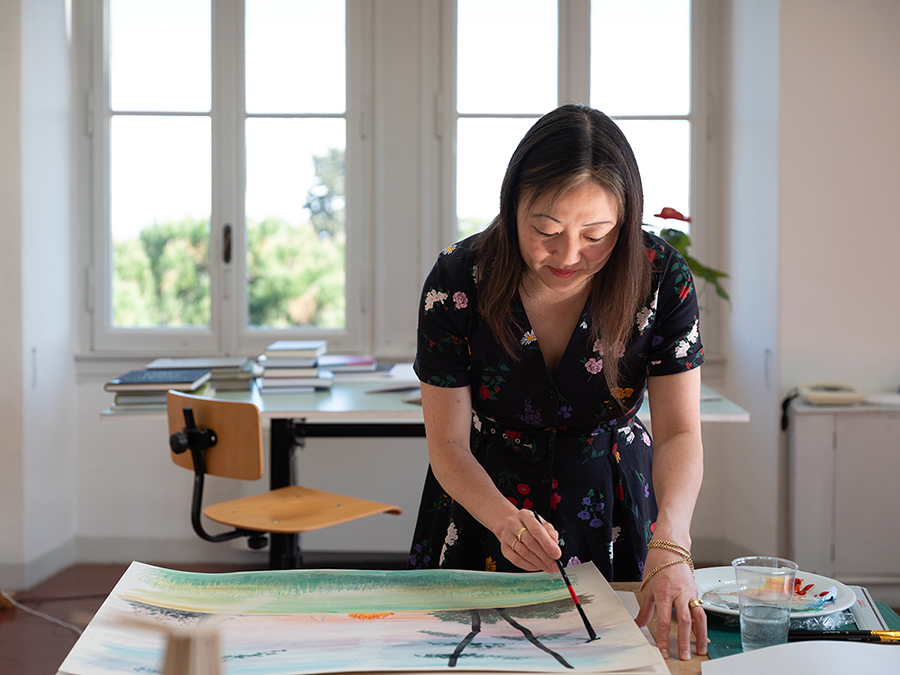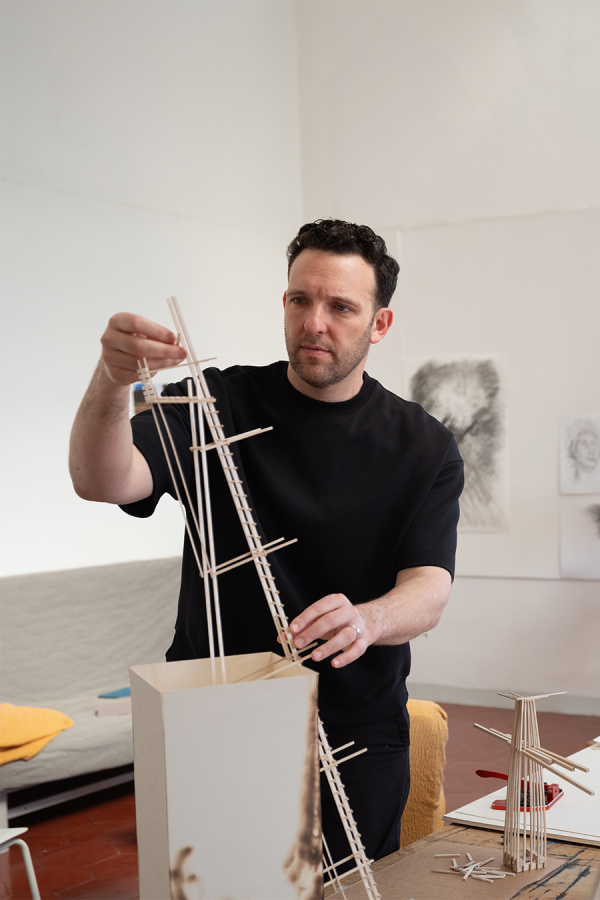Megumi Aihara and Dan Spiegel, the 2025 Garden Club of America | Prince Charitable Trusts Rome Prize Fellows in landscape architecture, are principals of the San Francisco–based design practice Spiegel Aihara Workshop. At the American Academy in Rome, they are developing Landscapes after the Fire, a project that examines how wildfire—long viewed as a destructive force—can also be read as a catalyst for cultural and ecological renewal. Drawing on representations of fire in literature, film, art, and the built environment, their research explores how scorched landscapes acquire new significance and how postfire sites might be reimagined for future habitation. In this interview, they reflect on the parallels between California and Italy, the architecture of resilience, and how their time in Rome has reshaped both their thinking and their community.
California, where your practice is based, has experienced devastating wildfires in recent years, including the awful blazes in January. How does your firsthand experience with these landscapes inform your approach to studying fire in a broader cultural and historical context?
We didn’t go looking for this topic—it came to us. Several years ago, we were hired to work on a project in Bonny Doon, California, which is a small town that had been decimated by the CZU-Lightning Complex fires in 2020. The simple task of replacing a home opened all kinds of questions of how and what to build, and whether to do it at all. As we dug in, it seemed that most available strategies were technical in nature—building hardening, defensible space, sprinkler systems, and so forth. But it was much harder to find a new relationship between wildfire and human inhabitation in the contemporary built environment. Eventually, it became clear that wildfire is here to stay, and that it can be reconsidered as a beneficial element for many landscapes. So, if that’s the case, how can we apply the tools of architecture and landscape architecture (our practice is a hybrid of both) toward developing a more symbiotic future? How can we inhabit the landscape in a way that acknowledges and coexists with fire? If wildfire can be productive for ecosystems, what can it produce for cultural systems?
And while the California context has its own particularities, the broadness of this topic across geographies and timelines gave us a tremendous opportunity to explore a wide range of cultural responses to wildfire. The fire map is expanding, and now our built projects in Hawaii, Oregon, and Washington all contend with this new reality. Italy and California share a Mediterranean Climate profile, so Rome, with thousands of years of recorded history, was an ideal place to examine how people have coexisted with fires in the past and how we might rethink this relationship in the future.

Indeed, Rome is an ideal place to study themes of reconstruction and resilience. Are there specific sites, texts, or archives that have yielded surprising ideas?
Our first stop was the Domus Aurea—Nero’s vast complex of elaborately landscaped pleasure gardens and palace built over the ruins of the Great Fire of Rome. We were struck by Nero’s vision to replace the burnt city with new constructed landscapes, which is in stark contrast to current American codes that respond to today’s fires by pushing the landscape further away. Of course, Nero probably wasn’t primarily concerned with fire prevention, but the impulse to reintroduce the ecological system as a move beyond the fires was striking.
We were also surprised to learn the degree to which fires allowed for forms of political organization in Rome. Through research in the AAR Library, we learned, for instance, that widespread fear of deadly fires in the early Roman Empire empowered merchants to organize bands of slaves into their own fire brigades. These informal patrols grew to wield increasing authority, and Emperor Augustus was finally forced to organize his own fire night watch in 6 AD. These “vigiles” were essentially the first state firefighters/police force of Rome—a large consolidation of authority brought about by fire.
In your research, have you found any specific artistic, literary, or architectural representations that capture a paradox—fire as a force of destruction and renewal—in especially compelling ways?
There are so many, often presented in stark terms—think Prometheus giving fire to man, and in return suffering eternally. We became most drawn to the examples that used a visual language to present this paradox more ambiguously. For instance, in the Isao Takahata film Grave of the Fireflies, animated images of embers from the menacing firebombing of Tokyo blend into idyllic scenes of fireflies hovering in a field, inspiring joy and wonder in children looking for motivation to continue. We also became interested, for instance, in the work of the Italian artist Alberto Burri, who used combustion to compose paintings, sculptures, and eventually massive earthworks. These works captured the violence and danger of the methods that produced them, while depicting a sense of control, of intent, of beauty—and in the case of the Burri’s Il Grand Cretto, an attempt to process the enormous loss of an entire town (from an earthquake) through a new visual language emerging from his experiments in combustion. In this case, the language of fire provides a stable, living memorial.

How have your interactions with this year’s fellows and residents influenced your work or changed your perspective?
This is an incredible group: brilliant, open about their work, and generous with feedback and recommendations. Chance conversations have led us in new directions, from the postfire forests in Palermo, to the new and old towns of Gibellina, to the volcanic villages of Stromboli. The Italian fellows in architecture plugged us into the current and historical discourses in Roman architecture, while the affiliated artists shared their own explorations of fire and combustibility. Our shoptalk with Francesco Urbano Ragazzi even pushed us to reconsider the nature of partnership and collaboration.
How did your conceptions of the Academy change over the course of the fellowship?
We were told by past fellows that the beauty of their studio spaces at the Academy brought them to tears, and indeed we found the studios to be incredible and inspiring spaces, well suited for each fellow in specific ways. However, we were unprepared for how much the living arrangements at the Academy enriched our daily lives. Having fellows live, work, and dine together in such close proximity meant we always had a friend available for a quick chat or to offer a new perspective. It’s been a revelation that our social worlds have such an enriching effect on our professional thinking. As we face leaving the Academy, we really hope to keep the connections to these fellows alive, and to find new ways to prioritize community back home, even when living apart in our own separate dwellings. As an aside, we’ve worked on co-living projects in our practice and teaching, and AAR has proven to be an extraordinary example!